Hotpoint WMSD 601 B EU Operating Instructions

Instructions for use
WASHING MACHINE
GB CZ HU
English,1 Česky,13 Magyar,25
Contents |
GB |
|
Installation, 2-3
Unpacking and levelling
Connecting the electricity and water supplies
The first wash cycle
Technical data
RO PL
Română,37 Polski,49
Care and maintenance, 4
Cutting off the water or electricity supply Cleaning the washing machine Cleaning the detergent dispenser drawer
Caring for the door and drum of your appliance Cleaning the pump
Checking the water inlet hose
WMSD 601
Precautions and tips, 5
General safety
Disposal
Opening the porthole door manually
Description of the washing machine, 6-7
Control panel Display
Running a wash cycle, 8
Wash cycles and functions, 9
Table of wash cycles Wash functions
Detergents and laundry, 10
Detergent dispenser drawer
Preparing the laundry
Special wash cycles
Load balancing system
Troubleshooting, 11
Service, 12
1
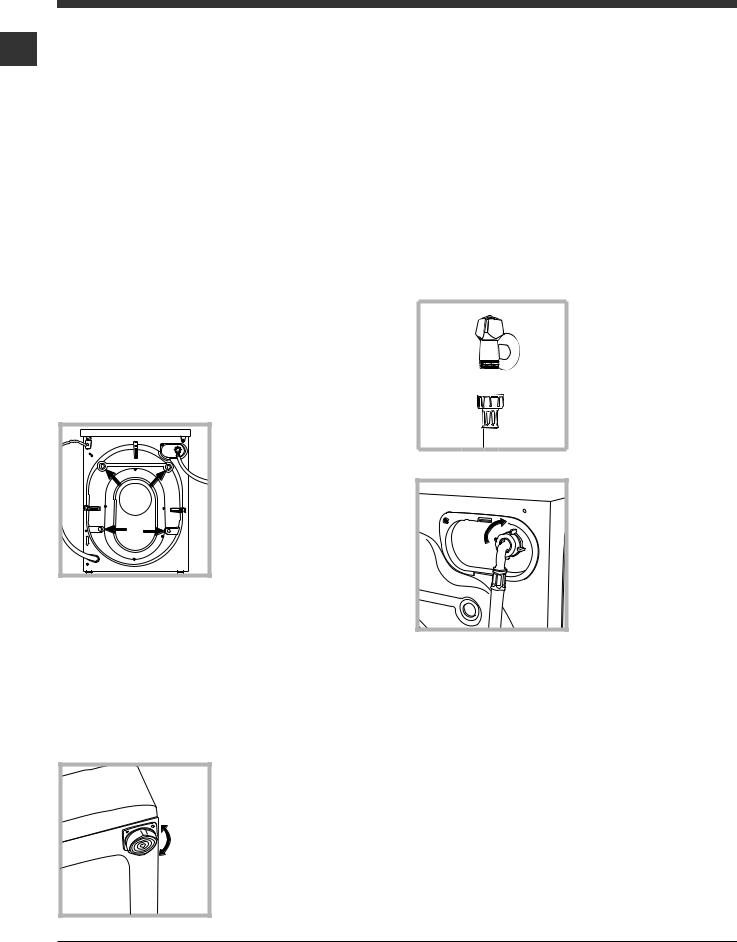
Installation
! This instruction manual should be kept in a GB safe place for future reference. If the washing machine is sold, transferred or moved, make sure that the instruction manual remains with the machine so that the new owner is able to
familiarise himself/herself with its operation and features.
! Read these instructions carefully: they contain vital information relating to the safe installation and operation of the appliance.
Unpacking and levelling
Unpacking
1.Remove the washing machine from its packaging.
2.Make sure that the washing machine has not been damaged during the transportation process. If it has been damaged, contact the retailer and do not proceed any further with the installation process.
3. Remove the 4 protective screws (used during transportation) and the rubber washer with the corresponding spacer, located on the rear part of the appliance (see figure).
4.Close off the holes using the plastic plugs provided.
5.Keep all the parts in a safe place: you will need them again if the washing machine needs to be moved to another location.
! Packaging materials should not be used as toys for children.
Levelling
1. Install the washing machine on a flat sturdy floor, without resting it up against walls, furniture cabinets or anything else.
2. If the floor is not perfectly level, compensate for any une-
venness by tightening or loosening the adjustable front feet (see figure); the angle of inclination, measured in relation to the worktop, must not exceed 2°.
Levelling the machine correctly will provide it with stability, help to avoid vibrations and excessive noise and prevent it from shifting
while it is operating. If it is placed on carpet or a rug, adjust the feet in such a way as to allow a sufficient ventilation space underneath the washing machine.
Connecting the electricity and water supplies
Connecting the water inlet hose
1. Connect the inlet hose by screwing it to a cold water tap using a 3/4 gas threaded connection (see figure).
Before performing the connection, allow the water to run freely until it is perfectly clear.
2. Connect the inlet hose to the washing machine by screwing it onto the corresponding water inlet of the appliance, which is situated on the top right-hand side of the rear part of the appliance (see figure).
3. Make sure that the hose is not folded over or bent.
!The water pressure at the tap must fall within the range of values indicated in the Technical data table (see next page).
!If the inlet hose is not long enough, contact a specialised shop or an authorised technician.
!Never use second-hand hoses.
!Use the ones supplied with the machine.
2
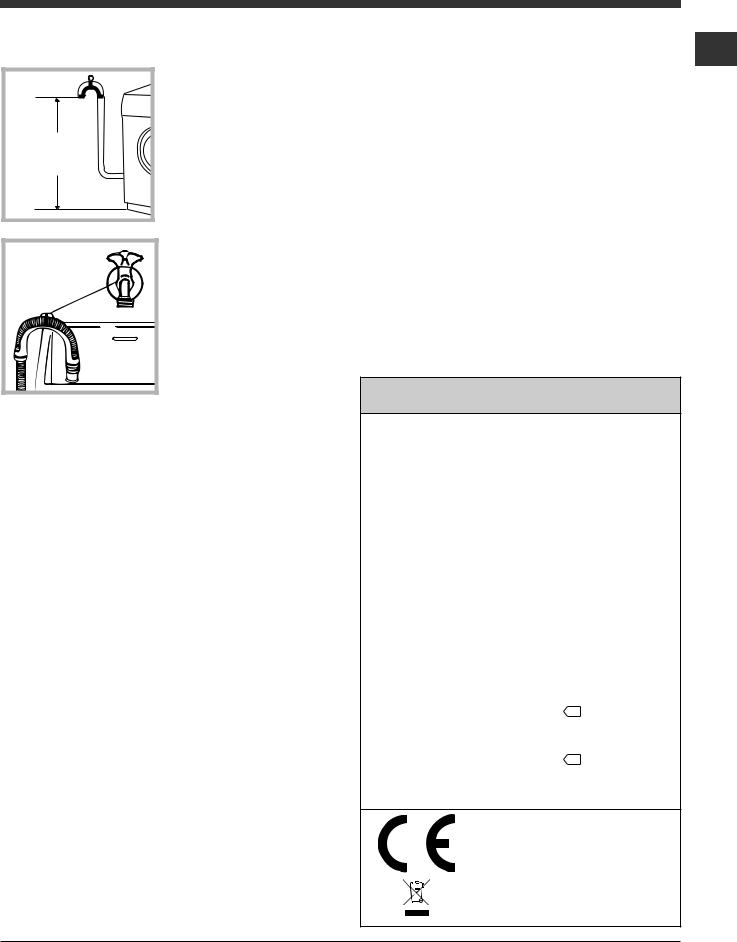
Connecting the drain hose
65 - 100 cm |
Connect the drain hose, without bending it, to a drain duct or a wall drain situated between 65 and 100 cm from the floor;
alternatively, placed it over the edge of a basin, sink or tub, fastening the duct supplied to the tap (see figure). The free end of the hose should not be underwater.
! We advise against the use of hose extensions; if it is absolutely necessary, the extension must have the same diameter as the original hose and must not exceed 150 cm in length.
Electrical connections
Before plugging the appliance into the electricity socket, make sure that:
•the socket is earthed and complies with all applicable laws;
•the socket is able to withstand the maximum power load of the appliance as indicated in the Technical data table (see opposite);
•the power supply voltage falls within the values indicated in the Technical data table (see
opposite);
• the socket is compatible with the plug of the washing machine. If this is not the case, replace the socket or the plug.
!The washing machine must not be installed outdoors, even in covered areas. It is extremely dangerous to leave the appliance exposed to rain, storms and other weather conditions.
!When the washing machine has been installed, the electricity socket must remain within easy reach.
! Do not use extension cords or multiple so- |
GB |
|
ckets. |
||
|
!The cable should not be bent or compressed.
!The power supply cable must only be replaced by authorised technicians.
Warning! The company shall not be held responsible in the event that these standards are not observed.
The first wash cycle
Once the appliance has been installed, and before you use it for the first time, run a wash cycle with detergent and no laundry, using wash cycle number “Auto Clean”.
Technical data
Model |
WMSD 601 |
|
|
|
|
|
|
Dimensions |
width 59.5 cm |
|
|
height 85 cm |
|
||
|
depth 42 cm |
|
|
Capacity |
from 1 to 6 kg |
|
|
|
|
||
Electrical |
please refer to the technical |
||
data plate fixed to the ma- |
|||
connections |
|||
chine |
|
||
|
maximum pressure |
||
Water con- |
1 MPa (10 bar) |
|
|
nections |
minimum pressure |
||
0.05 MPa (0.5 bar) |
|||
|
drum capacity 40 litres |
||
Spin speed |
up to 1000 rotations per |
||
minute |
|
||
Test wash |
programme |
(60°) |
|
cycles in |
|||
(1st press of the button); |
|||
accordan- |
|||
Cotton Standard 60°. |
|||
ce with |
|||
programme |
(40°) |
||
directives |
|||
(2nd press of the button); |
|||
1061/2010 |
|||
Cotton Standard 40°. |
|||
1015/2010 |
|
|
|
This appliance conforms to the following EC Directives: - 2004/108/EC (Electromagnetic Compatibility)
- 2006/95/EC (Low Voltage) - 2002/96/EC
3
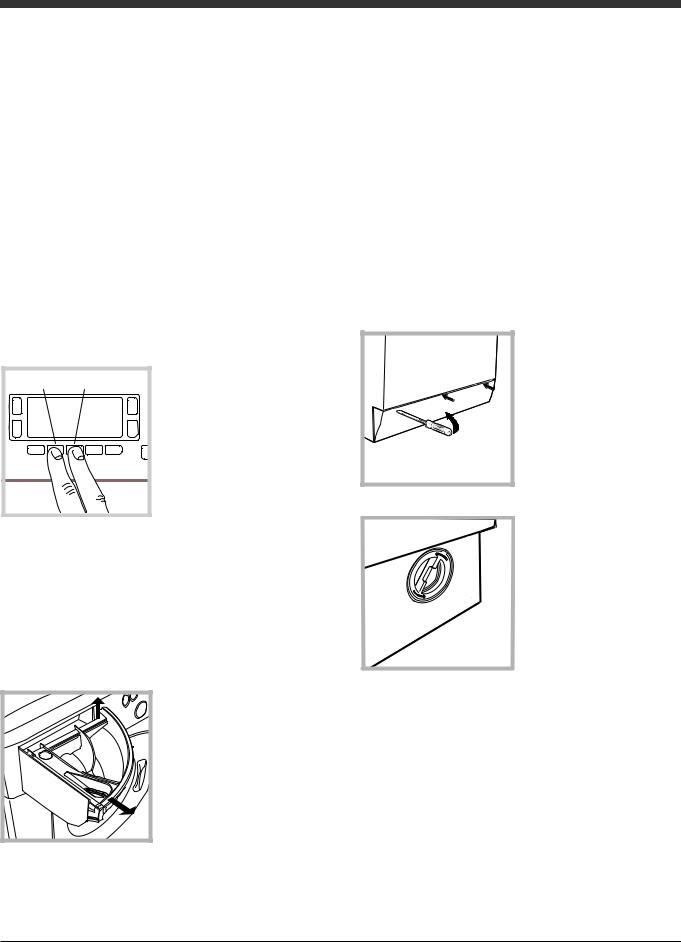
Care and maintenance
|
Cutting off the water and electri- |
|
GB |
||
city supplies |
||
|
• Turn off the water tap after every wash cycle. |
|
|
This will limit wear on the hydraulic system in- |
|
|
side the washing machine and help to prevent |
|
|
leaks. |
|
|
• Unplug the washing machine when cleaning |
|
|
it and during all maintenance work. |
|
|
Cleaning the washing machine |
•The outer parts and rubber components of the appliance can be cleaned using a soft cloth soaked in lukewarm soapy water. Do not use solvents or abrasives.
•The washing machine has a “Auto Clean” programme for its internal parts that must be
run with no load in the drum.
A |
B |
To help the wash cycle |
|
you may want to use |
|||
|
|
||
|
|
either the detergent |
|
|
|
(i.e. a quantity 10% the |
|
|
|
quantity specified for |
|
|
|
lightly-soiled garments) |
|
|
|
or special additives to |
|
|
|
clean the washing ma- |
|
|
|
chine. We recommend |
|
|
|
running a cleaning |
|
programme every 40 wash cycles. |
|||
To start the programme press buttons A and B simultaneously for 5 seconds (see figure). The programme will start automatically and will run for about 70 minutes. To stop the cycle press the START/PAUSE button.
Cleaning the detergent dispenser drawer
1 |
2 |
Remove the dispenser by raising it and pulling it out (see figure).
Wash it under running water; this operation should be repeated frequently.
Caring for the door and drum of your appliance
•Always leave the porthole door ajar in order to prevent unpleasant odours from forming.
Cleaning the pump
The washing machine is fitted with a self-clea- ning pump which does not require any maintenance. Sometimes, small items (such as coins or buttons) may fall into the pre-chamber which protects the pump, situated in its bottom part.
! Make sure the wash cycle has finished and unplug the appliance.
To access the pre-chamber:
1. using a screwdriver, remove the cover panel on the lower front part of the washing machine (see figure);
2. unscrew the lid by rotating it anticlockwise (see figure): a little water may trickle out. This is perfectly normal;
3.clean the inside thoroughly;
4.screw the lid back on;
5.reposition the panel, making sure the hooks are securely in place before you push it onto the appliance.
Checking the water inlet hose
Check the inlet hose at least once a year. If there are any cracks, it should be replaced immediately: during the wash cycles, water pressure is very strong and a cracked hose could easily split open.
! Never use second-hand hoses.
4
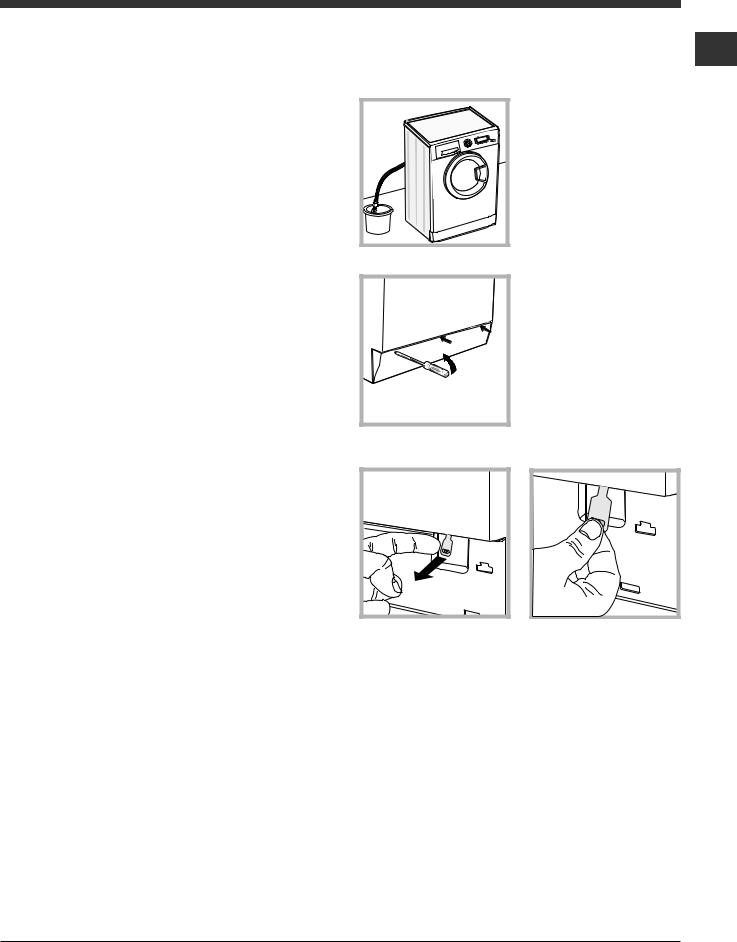
Precautions and tips
! This washing machine was designed and constructed in accordance with international safety regulations. The following information is provided for safety reasons and must therefore be read carefully.
General safety
•This appliance was designed for domestic use only.
•This appliance is not intended for use by persons (including children) with reduced physical, sensory or mental capabilities, or lack of experience and knowledge, unless they have been given supervision or instruction concerning use of the appliance by a person responsible for their safety. Children should be supervised to ensure that they do not play with the appliance.
•Do not touch the machine when barefoot or with wet or damp hands or feet.
•Do not pull on the power supply cable when unplugging the appliance from the electricity socket. Hold the plug and pull.
•Do not open the detergent dispenser drawer while the machine is in operation.
•Do not touch the drained water as it may reach extremely high temperatures.
•Never force the porthole door. This could damage the safety lock mechanism designed to prevent accidental opening.
•If the appliance breaks down, do not under any circumstances access the internal mechanisms in an attempt to repair it yourself.
•Always keep children well away from the appliance while it is operating.
•The door can become quite hot during the wash cycle.
•If the appliance has to be moved, work in a group of two or three people and handle it with the utmost care. Never try to do this alone, because the appliance is very heavy.
•Before loading laundry into the washing machine, make sure the drum is empty.
Disposal
•Disposing of the packaging materials: observe local regulations so that the packaging may be re-used.
•The European Directive 2002/96/EC on Waste Electrical and Electronic Equipment, requires that old household electrical appliances must not be disposed of in the normal unsorted municipal waste stream. Old appliances must be collected separately in order to optimise the recovery and recycling of the materials they contain and reduce the impact on human health and the environment. The crossed out “wheeled bin” symbol on the product reminds you of your obligation, that when you dispose of the appliance it must be separately collected. Consumers should contact their local authority or retailer for information concerning the correct disposal of their old appliance.
Opening the porthole door manually |
GB |
|
In the event that it is not possible to open the porthole |
||
|
||
door due to a powercut, and if you wish to remove the |
|
|
laundry, proceed as follows: |
|
|
1. remove the plug from the |
|
|
electrical socket. |
|
|
2. make sure the water level |
|
|
inside the machine is lower |
|
|
than the door opening; if it |
|
|
is not, remove excess water |
|
|
using the drain hose, collec- |
|
|
ting it in a bucket as indicated |
|
|
in the figure. |
|
|
3. using a screwdriver, remo- |
|
|
ve the cover panel on the lo- |
|
|
wer front part of the washing |
|
|
machine (see figure). |
|
4.pull outwards using the tab as indicated in the figure, until the plastic tie-rod is freed from its stop position; pull downwards and open the door at the same time.
5.reposition the panel, making sure the hooks are securely in place before you push it onto the appliance.
5
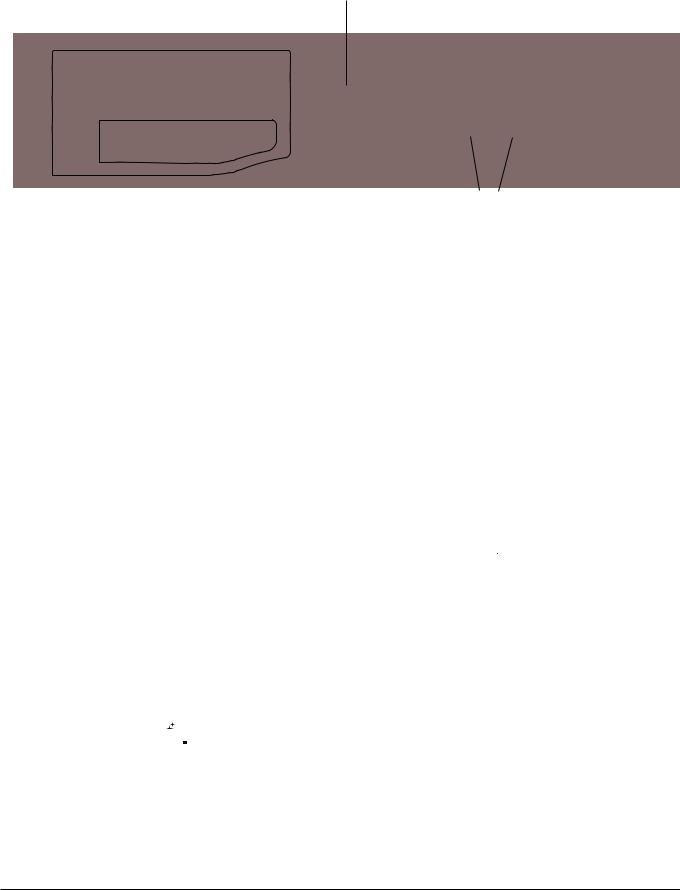
Description of the washing machine
|
|
|
|
|
|
|
|
|
Control panel |
|
CLEANING |
|
SPIN SPEED |
GB |
|
|
||||
|
|
|
||||
|
|
|
|
|||
|
|
ON/OFF |
|
ACTION |
|
button |
|
|
button |
|
button |
|
|
|
|
|
|
|
|
|
DISPLAY
|
|
|
|
|
|
|
|
|
|
START/PAUSE |
|
|
|
|
|
|
|
|
|
|
|
|
|
|
|
|
|
|
|
|
|
|
|
|
|
|
|
|
|
|
|
|
|
|
|
|
MY |
|
|
|
|
|
||
|
|
WASH |
|
|
|
|
|
button with |
||
|
|
CYCLE |
|
FUNCTION |
|
|
indicator light |
|||
|
|
CYCLE |
|
|
|
|||||
Detergent dispenser drawer |
button |
|
buttons |
|
|
|
||||
|
|
SELECTOR |
|
|
|
|
|
|
||
|
|
buttons |
|
|
|
|
|
|
|
|
|
|
|
|
|
|
DELAY |
|
TEMPERATURE |
||
|
|
|
|
|
|
TIMER |
|
|||
|
|
|
|
ANTI |
|
|
button |
|||
|
|
|
|
|
button |
|
|
|
||
|
|
|
ALLERGY |
|
|
|
CHILD LOCK |
|||
|
|
|
RINSE |
|
|
|
||||
|
|
|
|
|
|
button |
||||
|
|
|
|
button |
|
|
|
|||
|
|
|
|
|
|
|
|
|
|
|
Detergent dispenser drawer: used to dispense detergents and washing additives (see “Detergents and laundry”).
ON/OFF button  : press this briefly to switch the machine on or off. The START/PAUSE indicator light, which flashes slowly in a green colour shows that the machine is switched on. To switch off the washing machine during the wash cycle, press and hold the button for approximately 3 seconds; if the button is pressed briefly or accidentally the machine will not switch off. If the machine is switched off during a wash cycle, this wash cycle will be cancelled.
: press this briefly to switch the machine on or off. The START/PAUSE indicator light, which flashes slowly in a green colour shows that the machine is switched on. To switch off the washing machine during the wash cycle, press and hold the button for approximately 3 seconds; if the button is pressed briefly or accidentally the machine will not switch off. If the machine is switched off during a wash cycle, this wash cycle will be cancelled.
WASH CYCLE SELECTOR buttons: used to set the desired wash cycle (see “Table of wash cycles”).
MY CYCLE button: press and hold the button to store a cycle with your own set of preferences in the memory of the machine. To recall a previously stored cycle, press the MY CYCLE button.
FUNCTION buttons: press the button to select the desired function. The corresponding indicator light on the display will switch on.
CLEANING ACTION button  : to select the desired wash intensity.
: to select the desired wash intensity.
ANTI ALLERGY RINSE button  : press to select the desired rinse type.
: press to select the desired rinse type.
SPIN button  : press to reduce or completely exclude the spin cycle - the value is indicated on the display.
: press to reduce or completely exclude the spin cycle - the value is indicated on the display.
TEMPERATURE button  : press to decrease the temperature: the value will be shown on the display.
: press to decrease the temperature: the value will be shown on the display.
CHILD LOCK button  : to activate the control panel lock, press and hold the button for approximately 2 seconds. When the symbol
: to activate the control panel lock, press and hold the button for approximately 2 seconds. When the symbol  is illuminated, the control panel is locked (apart from the ON/OFF button). This means it is possible to prevent wash cycles from being modified accidentally, especially where there are children in the home. To deactivate the control panel lock, press and hold the button for approximately 2 seconds.
is illuminated, the control panel is locked (apart from the ON/OFF button). This means it is possible to prevent wash cycles from being modified accidentally, especially where there are children in the home. To deactivate the control panel lock, press and hold the button for approximately 2 seconds.
DELAY TIMER button  : press to set a delayed start time for the selected wash cycle. The delay time will be shown on the display.
: press to set a delayed start time for the selected wash cycle. The delay time will be shown on the display.
START/PAUSE button with indicator light: when the green indicator light flashes slowly, press the button to start a wash cycle. Once the cycle has started the indicator light will remain lit in a fixed manner. To pause the wash cycle, press the button again; the indicator light will flash in an orange colour. If the symbol  is not illuminated, the door may be opened. To start the wash cycle from the point at which it was interrupted, press the button again.
is not illuminated, the door may be opened. To start the wash cycle from the point at which it was interrupted, press the button again.
Standby mode
This washing machine, in compliance with new energy saving regulations, is fitted with an automatic standby system which is enabled after about 30 minutes if no activity is detected. Press the ON-OFF button briefly and wait for the machine to start up again.
Consumption in off-mode: 0,5 W Consumption in Left-on: 0,5 W
6
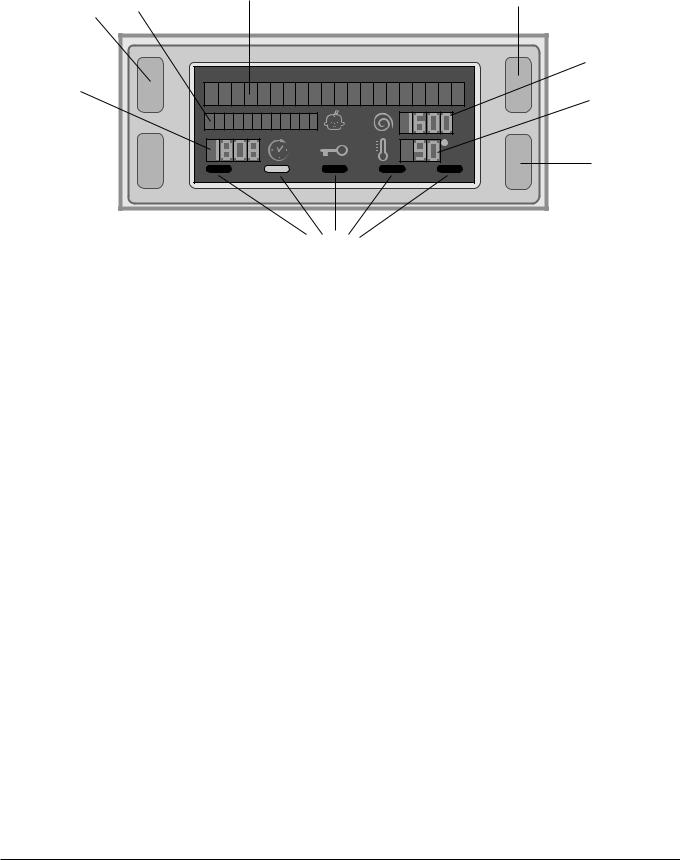
|
|
|
|
|
|
Display |
|
|
|
|
|
|
|
|
|
GB |
|
|
|
|
|
|
|
|
|
A |
|
|
|
Z |
B |
X |
|||
|
|
|
|
|
|
|
D |
C |
E |
|
|
|
Y |
F
The display is useful when programming the machine and provides a great deal of information.
The two upper strings A and B provide details of the wash cycle selected, the wash cycle phase in progress and all information relating to the progress status of the wash cycle.
String C shows the time remaining until the end of the wash cycle in progress and, if a DELAYED START has been set, the time remaining until the start of the selected wash cycle.
String D shows the maximum spin speed value (this depends on the selected wash cycle); if the wash cycle does not include a spin cycle, the string remains unused.
String E shows the maximum temperature value which may be selected (this depends on the wash cycle used); if the temperature of the wash cycle cannot be modified, the string remains unused.
Indicator lights F correspond to the functions and light up when the selected function is compatible with the set wash cycle.
Door locked symbol 
If the symbol is lit, this indicates that the washing machine door is blocked to prevent it from being opened accidentally. To prevent any damage from occurring, wait for the symbol to switch itself off before opening the appliance door.
N.B.: if the DELAYE TIMER function has been activated, the door cannot be opened; pauses the machine by pressing the START/PAUSE button if you wish to open it.
! The first time the machine is switched on, you will be asked to select the language and the display will automatically show the language selection menu.
To select the desired language press the X and Y buttons; to confirm the selection press the Z button.
To change the language switch off the machine and press buttons X, Y, Z simultaneously until an alarm is heard: the language-selection menu will be displayed again.
7

Running a wash cycle
1. SWITCH THE MACHINE ON. Press the On/Off
GB button  ; the text POWER ON will appear on the display and the START/PAUSE indicator light will flash slowly in a green colour.
; the text POWER ON will appear on the display and the START/PAUSE indicator light will flash slowly in a green colour.
2.LOAD THE LAUNDRY. Open the porthole door. Load the laundry, making sure you do not exceed the maximum load value indicated in the table of programmes on the following page.
3.MEASURE OUT THE DETERGENT. Open the detergent dispenser drawer and pour the detergent into the relevant compartments as described in “Detergents and laundry”.
4.CLOSE THE DOOR.
5.SELECT THE WASH CYCLE. Press one of the WASH CYCLE SELECTOR buttons to select the required wash cycle; the name of the wash cycle will appear on the display. A temperature and spin speed is set for each wash cycle; these may be adjusted. The duration of the cycle will appear on the display.
6.CUSTOMISE THE WASH CYCLE. Use the relevant buttons:

 Modifying the temperature and/or spin speed. The machine automatically selects the maximum temperature and spin speed set for the selected wash cycle; these values cannot therefore be increased. The temperature can be decreased by
Modifying the temperature and/or spin speed. The machine automatically selects the maximum temperature and spin speed set for the selected wash cycle; these values cannot therefore be increased. The temperature can be decreased by
pressing the  button, until the cold wash “OFF” setting is reached. The spin speed may be progressively reduced by pressing the
button, until the cold wash “OFF” setting is reached. The spin speed may be progressively reduced by pressing the  button, until it is completely excluded (the “OFF” setting). If these buttons are
button, until it is completely excluded (the “OFF” setting). If these buttons are
pressed again, the maximum values are restored.
! Exception: if the  (60°) (1st press of the button)
(60°) (1st press of the button)
programme is selected, the temperature can be increased up to a value of 90°C.
Setting a delayed start.
To set a delayed start for the selected programme, press the corresponding button repeatedly until the required delay period has been reached. When this option is enabled, the 

 symbol lights up on the display. To remove the delayed start function press the button until the text “OFF” appears on the display.
symbol lights up on the display. To remove the delayed start function press the button until the text “OFF” appears on the display.
Set the desired wash intensity.
Option makes it possible to optimise washing
makes it possible to optimise washing
based on the level of soil in the fabrics and on desired wash cycle intensity.
Select the wash programme: the cycle will be automatically set to “Normal” as optimised for garments with an average level of soil (this setting is not applicable to the “Wool” cycle, which is automatically set to “Delicate”). For heavily-soiled garments press button until
until
the “Super Wash” level is reached. This level ensures a high-performance wash due to a larger quantity of water used in the initial phase of the cycle and due to increased drum rotation. It is useful when removing the most stubborn stains.
It can be used with or without bleach. If you wish to bleach the items insert the additional compartment (4) into compartment 1. When pouring the bleach, be careful not to exceed the “max” level marked on the central pivot (see figure pag. 10).
For lightly-soiled garments or a more delicate treatment of the fabrics, press button until the “Delicate” level is reached.
until the “Delicate” level is reached.
The cycle will reduce the drum rotation to ensure washing results are perfect for delicate garments.
Set the rinse type.
Option makes it possible to select the desired rinse type for sensitive skin. Press the button once for the “Extra Rinse” level, which makes it possible to select an additional rinse after the standard cycle rinse and remove all traces of detergent. Press the button again for the “Sensitive Skin” level, which makes it possible to select two additional rinses to the standard cycle rinses; it is recommended for very sensitive skin. Press the button for the third time for the “Anti allergy Rinse” level, which makes it possible to select three additional rinses to the standard cycle rinses and remove major allergens such as pollen, mites, cat and dog hair. Press the button again to go back to the “Normal Rinse” rinse type. If the current adjustment can be neither set nor changed, the display will show “Not allowed”.
Modifying the cycle settings.
•Press the button to enable the function; the indicator light corresponding to the button will switch on.
•Press the button again to disable the function; the indicator light will switch off.
!If the selected function is not compatible with the programmed wash cycle, the indicator light will flash and the function will not be activated.
!If the selected function is not compatible with another function which has been selected previously, the indicator light corresponding to the first function selected will flash and only the second function will be activated; the indicator light corresponding to the enabled function will remain lit.
!The functions may affect the recommended load value and/or the duration of the cycle.
7.START THE PROGRAMME. Press the START/PAUSE button. The corresponding indicator light will become green, remaining lit in a fixed manner, and the door will be locked (the DOOR LOCKED symbol will be on). During the wash cycle, the name of the phase in progress will appear on the display. To change a wash cycle while
it is in progress, pause the washing machine using the START/PAUSE button (the START/PAUSE indicator light will flash slowly in an orange colour); then select the desired cycle and press the START/PAUSE button again. To open the door while a cycle is in progress, press
the START/PAUSE button; if the DOOR LOCKED  symbol is switched off the door may be opened. Press the START/PAUSE button again to restart the wash cycle from the point at which it was interrupted.
symbol is switched off the door may be opened. Press the START/PAUSE button again to restart the wash cycle from the point at which it was interrupted.
8.THE END OF THE WASH CYCLE. This will be indicated by the text “END OF CYCLE” on the display; when the DOOR LOCKED  symbol switches off the door may be opened. Open the door, unload the laundry and switch off the machine.
symbol switches off the door may be opened. Open the door, unload the laundry and switch off the machine.
! If you wish to cancel a cycle which has already begun, press and hold the  button. The cycle will be stopped and the machine will switch off.
button. The cycle will be stopped and the machine will switch off.
8
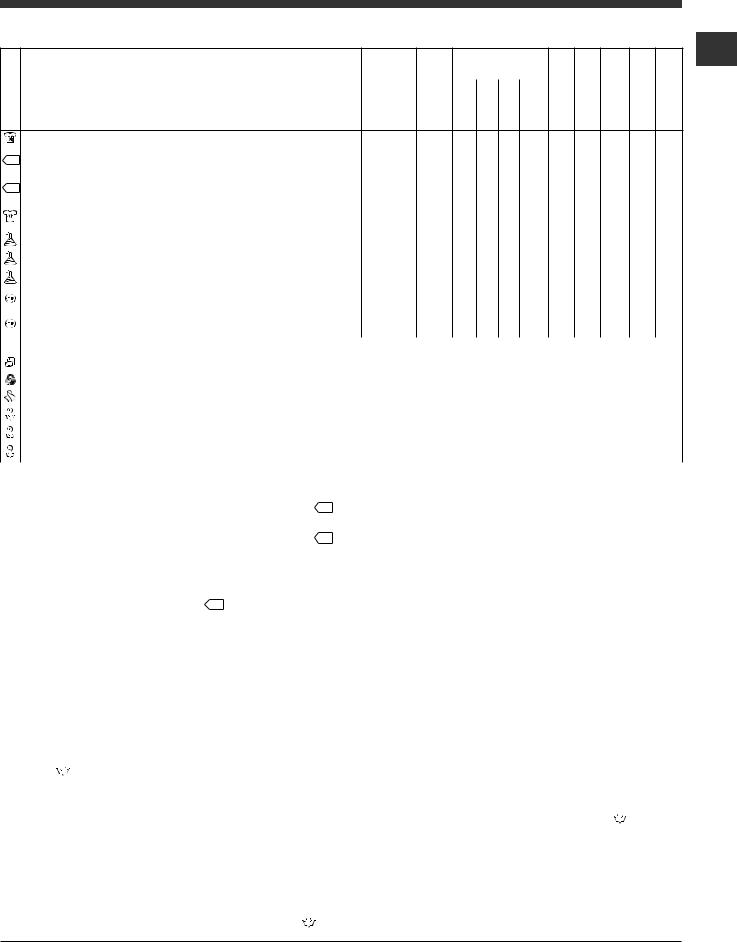
Wash cycles and functions
Table of wash cycles
|
|
|
|
|
|
|
|
|
|
dam |
- |
|
|
|
|
|
|
|
|
|
|
|
|
consum |
|
|
|
cyclesWash |
|
|
|
Prewash |
Wash |
Bleach |
Fabric softener loadMax. |
(kg) |
- |
Energy |
waterTotallt |
durationCycle |
|
|
|
|
Residual |
||||||||||
|
|
|
|
|
Detergents |
|
% |
kWh |
|
|
|||
|
|
Max. |
Max. |
|
|
|
|
|
|
pness |
ption |
|
|
|
Description of the wash cycle |
temp. |
speed |
|
|
|
|
|
|
|
|
||
|
|
(°C) |
(rpm) |
|
|
|
|
|
|
|
|
|
|
Anti Stain |
40° |
1000 |
|
|
- |
|
3 |
- |
- |
- |
170’ |
|
Cotton Standard 60° (1st press of the button) (1): heavily soiled whites |
60° |
1000 |
|
|
|
|
6 |
62 |
1,07 |
50 |
190’ |
|
and delicate colours. |
(Max. 90°) |
(3) |
||||||||||
Cotton Standard 40° (2nd press of the button) (2): lightly soiled whites |
40° |
1000 |
- |
|
|
|
6 |
62 |
1,09 |
92 |
175’ |
|
and delicate colours. |
||||||||||||
|
|
|
|
|
|
|
|
|
|
|
||
Cotton Standard 20° (3rd press of the button): lightly soiled whites and |
20° |
1000 |
- |
|
|
|
6 |
- |
- |
- |
170’ |
|
delicate colours. |
||||||||||||
|
|
|
|
|
|
|
|
|
|
|
||
Synthetics (1st press of the button): heavily soiled resistant colours. |
60° |
800 |
|
|
|
|
3 |
44 |
0,70 |
40 |
105’ |
|
|
|
|
|
|
|
|
|
|
|
|
|
|
Synthetics (1st press of the button) (4): lightly soiled resistant colours. |
40° |
800 |
|
|
|
|
3 |
44 |
0,47 |
38 |
95’ |
|
|
|
|
|
|
|
|
|
|
|
|
|
|
Synthetics (2nd press of the button): lightly soiled delicate colours. |
40° |
800 |
|
|
|
|
3 |
- |
- |
- |
75’ |
|
|
|
|
|
|
|
|
|
|
|
|
|
|
Fast Wash 60' (1st press of the button): to refresh normal soiled garments quic- |
60° |
1000 |
- |
|
- |
|
3,5 |
62 |
0,71 |
35 |
60’ |
|
kly (not suitable for wool, silk and clothes which require washing by hand). |
||||||||||||
|
|
|
|
|
|
|
|
|
|
|
||
Fast Wash 30' (2nd press of the button): to refresh lightly soiled garments quic- |
30° |
800 |
- |
|
- |
|
3 |
71 |
0,06 |
39 |
30’ |
|
kly (not suitable for wool, silk and clothes which require washing by hand). |
||||||||||||
|
|
|
|
|
|
|
|
|
|
|
||
M My Cycle: allows for any wash cycle to be stored. |
|
|
|
|
|
|
|
|
|
|
|
|
Bed&Bath: washes bathroom laundry and bedlinen. |
60° |
1000 |
|
|
- |
|
6 |
- |
- |
- |
95’ |
|
|
|
|
|
|
|
|
|
|
|
|
|
|
Wool: for wool, cashmere, etc. |
40° |
800 |
- |
|
- |
|
1 |
- |
- |
- |
55’ |
|
Delicates |
30° |
0 |
- |
|
- |
|
1 |
- |
- |
- |
75’ |
|
Spin (1st press of the button) |
- |
1000 |
- |
- |
- |
- |
6 |
- |
- |
- |
16’ |
|
|
|
|
|
|
|
|
|
|
|
|
|
|
Rinse (2nd press of the button) |
- |
1000 |
- |
- |
- |
|
6 |
- |
- |
- |
36’ |
|
|
|
|
|
|
|
|
|
|
|
|
|
|
Pump out (3rd press of the button) |
- |
0 |
- |
- |
- |
- |
6 |
- |
- |
- |
2’ |
|
|
|
|
|
|
|
|
|
|
|
|
|
The length of cycle shown on the display or in this booklet is an estimation only and is calculated assuming standard working conditions. The actual duration can vary according to factors such as water temperature and pressure, the amount of detergent used, the amount and type of load inserted, load balancing and any wash options selected.
1) Test wash cycle in compliance with directive 1061/2010: set wash cycle 60°C (1st press of the button).
This cycle is designed for cotton loads with a normal soil level and is the most efficient in terms of both electricity and water consumption; it should be used for garments which can be washed at 60°C. The actual washing temperature may differ from the indicated value.
2) Test wash cycle in compliance with directive 1061/2010: set wash cycle 40°C (2nd press of the button).
This cycle is designed for cotton loads with a normal soil level and is the most efficient in terms of both electricity and water consumption; it should be used for garments which can be washed at 40°C. The actual washing temperature may differ from the indicated value.
3) At 60 °C the “Prewash” function cannot be selected.
For all Test Institutes:
2) Long wash cycle for cottons: set wash cycle |
40°C (2nd press of the button). |
4) Long wash cycle for synthetics: set wash cycle 60°C (1st press of the button); temperature of 40°C (press TEMPERATURE button).
60°C (1st press of the button); temperature of 40°C (press TEMPERATURE button).
Wash functions
 Prewash
Prewash
If this function is selected, the pre-wash cycle will run; this is useful for removing stubborn stains.
N.B.: put the detergent in the relevant compartment. ! It cannot be used in conjunction with wash cycles


 ,
,  ,
,  ,
,  ,
,  (60°),
(60°),  (40°),
(40°),  .
.
 Easy Iron
Easy Iron
By selecting this function, the wash and spin cycles will be modified in order to reduce the formation of creases.
At the end of the cycle the washing machine will perform slow rotations of the drum; the “Easy Iron” and START/ PAUSE indicator lights will flash (orange) and the text “END OF CYCLE” will appear on the display. To end the cycle, press the START/PAUSE button or the “Easy Iron” button. ! It cannot be used with the  , “Fast Wash 30’”,
, “Fast Wash 30’”,  ,
,  ,
,  .
.
 Eco Wash
Eco Wash
The Eco Wash function saves energy by not heating the water used to wash your laundry – an advantage both to the environment and to your energy bill. Instead, intensified wash action and water optimisation ensure great wash results in the same average time of a standard cycle.
For the best washing results we recommend the usage of a liquid detergent.
! It cannot be used with the  ,
,  ,
,  ,
,  ,
,  ,
,  .
.
GB
9
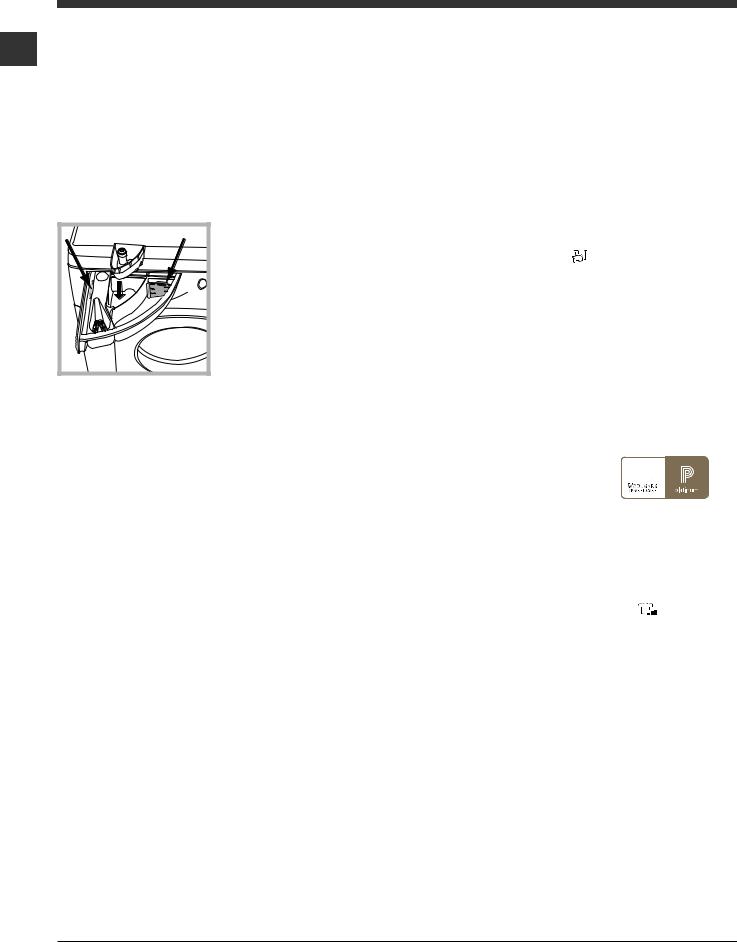
Detergents and laundry
Detergent dispenser drawer
GB
Good washing results also depend on the correct dose of detergent: adding too much detergent will not necessarily result in a more efficient wash, and may in fact cause a build up on the inside of your appliance and contribute to environmental pollution.
!Use powder detergent for white cotton garments, for pre-washing, and for washing at temperatures over 60°C.
!Follow the instructions given on the detergent packaging.
!Do not use hand washing detergents because these create too much foam.
B |
A |
MAX |
4 |
|
1 |
3 |
2 |
|
Open the detergent dispenser drawer and pour in the detergent or washing additive, as follows.
compartment 1: Pre-wash detergent (powder)
Before pouring in the detergent, make sure that extra compartment 4 has been removed.
compartment 2: Detergent for the wash cycle (powder or liquid)
If liquid detergent is used, it is recommended that the removable plastic partition A (supplied) be used for proper dosage.
If powder detergent is used, place the partition into slot B. compartment 3: Additives (fabric softeners, etc.)
The fabric softener should not overflow the grid. extra compartment 4: Bleach
Preparing the laundry
•Divide the laundry according to:
-the type of fabric/the symbol on the label
-the colours: separate coloured garments from whites.
•Empty all garment pockets and check the buttons.
•Do not exceed the listed values, which refer to the weight of the laundry when dry: see “Table of wash cycles”.
How much does your laundry weigh?
1 sheet 400-500 g
1 pillow case 150-200 g
1 tablecloth 400-500 g
1 bathrobe 900-1200 g
1 towel 150-250 g
Special wash cycles
Anti Stain  : this programme is suitable to heavily-soiled garments with resistant colours. It ensures a washing class that is higher than the standard class (A class). When running the programme, do not mix garments of different colours. We recommend the use of powder detergent. Pre-treatment with special additives is recommended if there are obstinate stains.
: this programme is suitable to heavily-soiled garments with resistant colours. It ensures a washing class that is higher than the standard class (A class). When running the programme, do not mix garments of different colours. We recommend the use of powder detergent. Pre-treatment with special additives is recommended if there are obstinate stains.
Cotton Standard 20°  : ideal for heavily soiled cotton loads. The effective performance levels achieved at cold temperatures, which are comparable to washing at 40°, are guaranteed by a mechanical action which operates at varying speed, with repeated and frequent peaks.
: ideal for heavily soiled cotton loads. The effective performance levels achieved at cold temperatures, which are comparable to washing at 40°, are guaranteed by a mechanical action which operates at varying speed, with repeated and frequent peaks.
Bed&Bath: use programme |
to wash bed linen |
and towels in one single cycle: it optimises softener |
|
performance and helps you save time and energy. We recommend the use of powder detergent.
Wool: the wool wash cycle on this Hotpoint/Ariston machine has been tested and approved by The Woolmark Company for washing wool garments labelled as hand washable provided that the garments are washed according to the instructions on the garment label and those issued by the manufacturer of this washing machine. Hotpoint/Ariston is the first washing machine brand to be approved by The Woolmark Company for Apparel CarePlatinum for its washing performance and consumption of energy and water. (M1128) 


In UK, Eire, Hong Kong and India the Woolmark trade mark is a Certification trade mark.
Delicates: use programme  to wash very delicate garments with decorative features, such as diamantes and sequins.
to wash very delicate garments with decorative features, such as diamantes and sequins.
To wash silk garments and curtains select the cycle  and set the “Delicate” level from option
and set the “Delicate” level from option .
.
We recommend turning the garments inside out before washing and placing small items into the special bag for washing delicates. Use liquid detergent on delicate garments for best results.
Load balancing system
Before every spin cycle, to avoid excessive vibrations and to distribute the load in a uniform manner, the drum rotates continuously at a speed which is slightly greater than the washing rotation speed. If, after several attempts, the load is not balanced correctly, the machine spins at a reduced spin speed. If the load is excessively unbalanced, the washing machine performs the distribution process instead of spinning. To encourage improved load distribution and balance, we recommend small and large garments are mixed in the load.
10

Troubleshooting
|
|
|
|
|
Your washing machine could fail to work. Before contacting the Technical Assistance Centre (see “Assistance”), make sure |
|
|||
GB |
||||
that the problem cannot be not solved easily using the following list. |
||||
|
||||
Problem: |
Possible causes / Solutions: |
|
||
|
||||
The washing machine does not switch on.
The wash cycle does not start.
•The appliance is not plugged into the socket fully, or is not making contact.
•There is no power in the house.
•The washing machine door is not closed properly.
•The ON/OFF button has not been pressed.
•The START/PAUSE button has not been pressed.
•The water tap has not been opened.
•A delayed start has been set (see “Running a wash cycle”).
The washing machine does not take in water (the text “NO WATER, CHECK SUPPLY” appears on the display).
•The water inlet hose is not connected to the tap.
•The hose is bent.
•The water tap has not been opened.
•There is no water supply in the house.
•The pressure is too low.
•The START/PAUSE button has not been pressed.
The washing machine continuously takes in and
drains water.
•The drain hose is not fitted at a height between 65 and 100 cm from the floor (see “Installation”).
•The free end of the hose is under water (see “Installation”).
•The wall drainage system is not fitted with a breather pipe.
If the problem persists even after these checks, turn off the water tap, switch the appliance off and contact the Assistance Service. If the dwelling is on one of the upper floors of a building, there may be problems relating to water drainage, causing the washing machine to fill with water and drain continuously. Special anti-draining valves are available in shops and help to avoid this inconvenience.
The washing machine does not drain or spin.
•The wash cycle does not include draining: some wash cycles require the drain phase to be started manually (see “Wash cycles and functions”).
•The EASY IRON function has been activated: To complete the wash cycle, press the START/PAUSE button (see “Wash cycles and functions”).
•The drain hose is bent (see “Installation”).
•The drainage duct is clogged.
The washing machine vibrates a lot |
• The drum was not unlocked correctly during installation (see “Installation”). |
during the spin cycle. |
• The washing machine is not level (see “Installation”). |
|
• The washing machine is trapped between cabinets and walls (see “Installation”). |
The washing machine leaks. |
• The water inlet hose is not screwed on properly (see “Installation”). |
|
• The detergent dispenser drawer is blocked (for cleaning instructions, see “Care |
|
and maintenance”). |
|
• The drain hose is not fixed properly (see “Installation”). |
The machine is locked and the display flashes, indicating an
error code (e.g. F-01, F-..).
There is too much foam.
•Switch off the machine and unplug it, wait for approximately 1 minute and then switch it back on again.
If the problem persists, contact the Technical Assistance Service.
•The detergent is not suitable for machine washing (it should display the text “for washing machines” or “hand and machine wash”, or the like).
•Too much detergent was used.
11

Service
|
|
|
|
|
|
Before calling for Assistance: |
|
GB |
|||
|
• Check whether you can solve the problem alone (see “Troubleshooting”); |
||
|
|
• Restart the programme to check whether the problem has been solved; |
|
|
|||
|
|
• If this is not the case, contact an authorised Technical Assistance Centre using the telephone number provided on the |
|
|
|
guarantee certificate. |
|
|
|
! Always request the assistance of authorised technicians. |
Have the following information to hand:
•the type of problem;
•the appliance model (Mod.);
•the serial number (S/N).
This information can be found on the data plate applied to the rear of the washing machine, and can also be found on the front of the appliance by opening the door.
12

Návod k použití
CZ
Česky
WMSD 601
PRAČKA
Obsah |
CZ |
|
Instalace, 14-15
Rozbalení a vyrovnání do vodorovné polohy
Připojení k elektrické a k vodovodní síti
První prací cyklus
Technické údaje
Údržba a péče, 16
Uzavření přívodu vody a vypnutí elektrického napájení Čištění pračky
Čištění dávkovače pracích prostředků Péče o dvířka a buben
Čištění čerpadla
Kontrola přítokové hadice na vod
Opatření a rady, 17
Základní bezpečnostní pokyny
Likvidace
Manuální otevření dvířeku
Popis pračky, 18-19
Ovládací panel
Displej
Jak provést prací cyklus, 20
Programy a funkce, 21
Tabulka pracích programů
Funkce praní
Prací prostředky a prádlo, 22
Dávkovač pracích prostředků
Příprava prádla
Speciální programy
Systém automatického vyvážení náplně
Poruchy a způsob jejich odstranění, 23
Servisní služba, 24
13
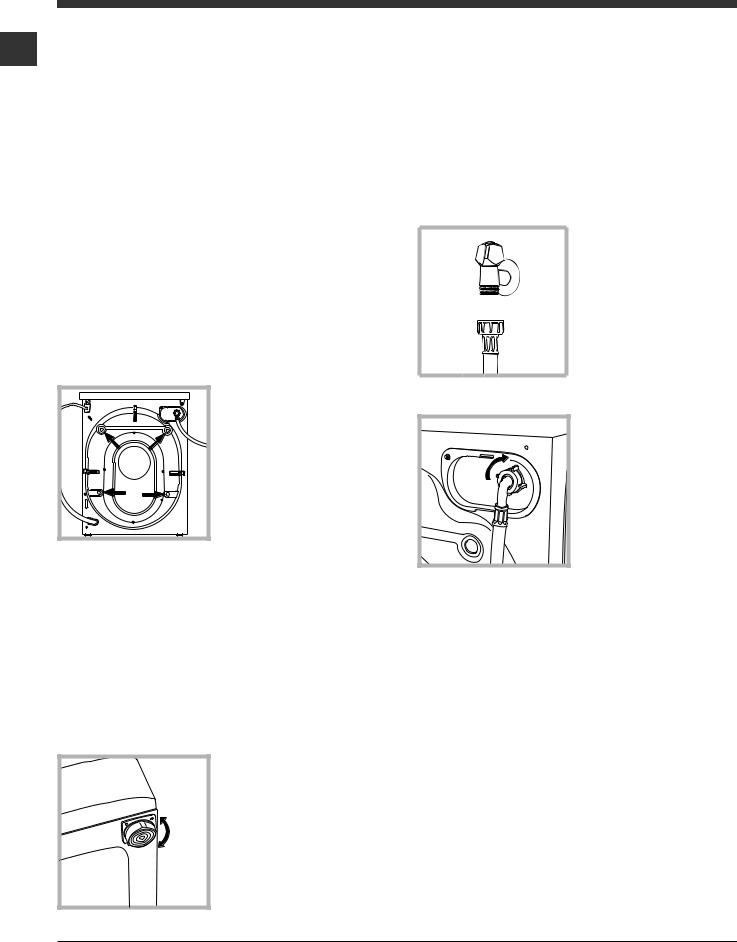
Instalace
! Je důležité uschovat tento návod tak, aby- CZ ste jej mohli kdykoli konzultovat. V případě prodeje, darování nebo přestěhování pračky
se ujistěte, že zůstane uložen v blízkosti pračky, aby mohl posloužit novému majiteli při seznámení s její činností a s příslušnými upozorněními.
! Pozorně si přečtěte uvedené pokyny: obsahují důležité informace týkající se instalace, použití a bezpečnosti při práci.
Rozbalení a vyrovnání do vodorovné polohy
Rozbalení
1.Rozbalte pračku.
2.Zkontrolujte, zda během přepravy nedošlo k jejímu poškození. V případě, že je poškozena, ji nezapojujte a obraťte se na prodejce.
3. Odstraňte 4 šrouby chránící před poškozením během přepravy a gumovou podložku s příslušnou rozpěrkou, které se nacházejí v zadní části (viz obrázek).
4.Uzavřete otvory po šroubech plastovými krytkami z příslušenství.
5.Uschovejte všechny díly: v případě opětovné přepravy pračky je bude třeba namontovat zpět.
! Obaly nejsou hračky pro děti!
Vyrovnání do vodorovné polohy
1. Pračku je třeba umístit na rovnou a pevnou podlahu, aniž by se opírala o stěnu, nábytek či něco jiného.
Dokonalé vyrovnání do vodorovné polohy zabezpečí stabilitu zařízení a zamezí vzniku vibrací a hluku během činnosti. V případě instalace na podlahovou krytinu nebo na koberec nastavte nožky tak, aby pod pračkou zůstal dostatečný volný prostor pro ventilaci.
Připojení k elektrické a k vodovodní síti
Připojení přítokové hadice vody
1. Připojte přívodní hadici jejím zašroubováním ke kohoutku studené vody s hrdlem se závitem 3/4“ (viz obrázek).
Před připojením hadice nechte vodu odtékat, dokud nebude čirá.
2. Připojte přítokovou hadici k pračce prostřednictvím příslušné přípojky na vodu, umístěné vpravo nahoře (viz obrázek).
3. Dbejte na to, aby hadice nebyla příliš ohnutá ani stlačená.
!Tlak v rozvodu vody se musí pohybovat v rozmezí hodnot uvedených v tabulce s technickými údaji (viz vedlejší strana).
!V případě, že délka přítokové hadice nebude dostatečná, obraťte se na specializovanou prodejnu nebo na autorizovaný technický personál.
!Nikdy nepoužívejte již použité hadice.
!Používejte hadice z příslušenství zařízení.
14

Připojení vypouštěcí hadice
65 - 100 cm |
Připojte vypouštěcí hadici, aniž byste ji ohýbali, k odpadovému potrubí nebo k odpadu ve stěně, který se nachází od 65 do 100 cm nad zemí;
nebo ji uchyťte k okraji umývadla či vany a připevněte vodicí držák
z příslušenství ke kohoutu (viz obrázek). Volný konec vypouštěcí hadice nesmí zůstat ponořený do vody.
! Použití prodlužovacích hadic se nedoporučuje; je-li však nezbytné, prodlužovací hadice musí mít stejný průměr jako originální hadice a její délka nesmí přesáhnout 150 cm.
Připojení k elektrické síti
Před zasunutím zástrčky do zásuvky se ujistěte, že:
•Je zásuvka uzemněna a že vyhovuje normám;
•je zásuvka schopna snést maximální zátěž odpovídající jmenovitému příkonu zařízení, uvedenému v tabulce s technickými údaji
(viz vedle);
•hodnota napájecího napětí odpovídá údajům uvedeným v tabulce s technickými údaji (viz vedle);
•je zásuvka kompatibilní se zástrčkou pračky. V opačném případě je třeba vyměnit zásuvku nebo zástrčku.
!Pračka nesmí být umístěna venku – pod širým nebem, a to ani v případě, že by se jednalo o místo chráněné před nepřízní počasí, protože je velmi nebezpečné vystavit ji působení deště a bouří.
!Po definitivní instalaci pračky musí zásuvka zůstat snadno přístupná.
!Nepoužívejte prodlužovací kabely a rozvodky.
! Kabel nesmí být ohnutý ani stlačený. |
|
|
CZ |
||
! Výměna kabelu musí být svěřena výhradně |
||
|
||
autorizovanému technickému personálu. |
|
|
Upozornění! Výrobce neponese žádnou |
|
|
odpovědnost za následky nerespektování |
|
|
uvedených předpisů. |
|
První prací cyklus
Po instalaci zařízení je třeba ještě předtím, než je použijete na praní prádla, provést jeden zkušební cyklus s pracím prostředkem a bez náplně prádla nastavením pracího programu „Samočištění“.
Technické údaje
Model |
WMSD 601 |
||
|
šíøka |
59,5 cm |
|
Rozmìry |
výška 85 cm |
||
|
hloubka 42 cm |
||
Kapacita |
od 1 do 6 kg |
||
Napájení |
Viz štítek s technickými úda- |
||
ji, aplikovaný na zarízení. |
|||
|
|||
|
maximální tlak |
||
Pøipojení k |
1 MPa (10 bar) |
||
minimální tlak |
|||
rozvodu vody |
|||
0.05 MPa (0.5 bar) |
|||
|
kapacita bubnu 40 litrù |
||
Rychlost |
a¡z do 1000 otáèek za minutu |
||
odstøeïování |
|||
Kontrolní |
program |
60° (1. sti- |
|
sknutí tlačítka); BAVLNA |
|||
programy |
|||
STANDARD 60°. |
|||
podle směrnic |
|||
1061/2010 a |
program |
40° (2. sti- |
|
1015/2010 |
sknutí tlačítka); BAVLNA |
||
STANDARD 40°. |
|||
|
|||
Toto zaøízení odpovídá následujícím normám Evropské unie:
-2004/108/CE (Elektromagnetická kompatibilita)
-2006/95/CE (Nízké napìtí)
- 2002/96/CE
Hluènost |
Praní: 62 |
|
(dB(A) |
||
Odstøeïování: 80 |
||
re 1 pW) |
||
|
15
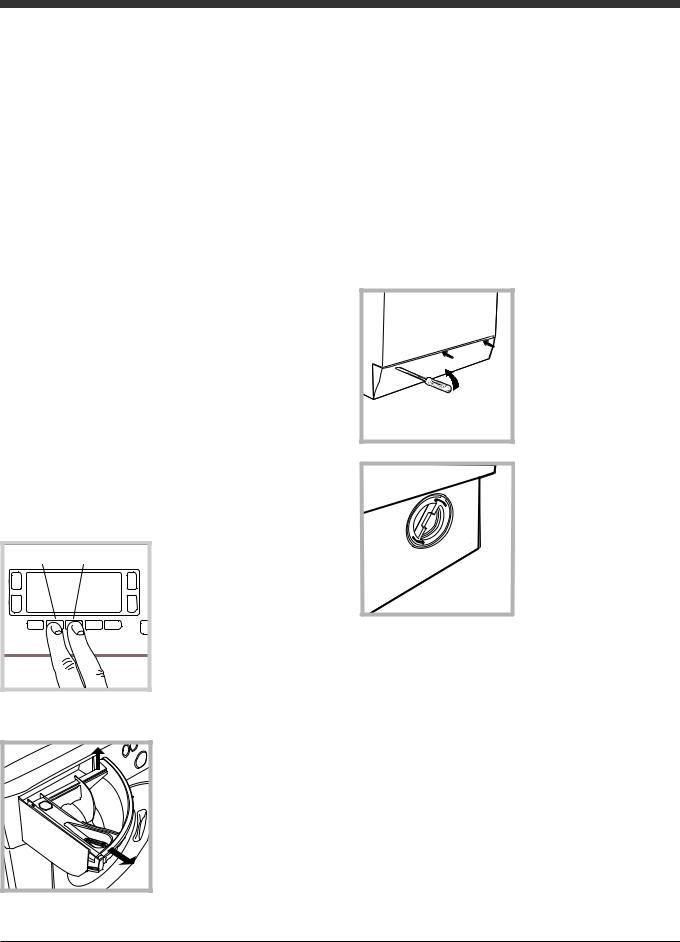
Údržba a péče
|
Uzavření přívodu vody a vypnutí |
|
CZ |
||
elektrického napájení |
||
|
• Po každém praní uzavřete přívod vody. |
|
|
Tímto způsobem dochází k omezení |
|
|
opotřebení pračky a ke snížení nebezpečí |
|
|
úniku vody. |
|
|
• Před zahájením čištění pračky a během |
|
|
operací údržby vytáhněte zástrčku |
|
|
napájecího kabelu z elektrické zásuvky. |
Čištění pračky
• Vnější části a části z gumy se mohou čistit hadrem navlhčeným ve vlažné vodě a saponátu. Nepoužívejte rozpouštědla ani abrazivní látky.
• Pračka je vybavena programem „SAMOČIŠTĚNÍ“ vnitřních částí, který musí být proveden bez jakéhokoli druhu náplně v bubnu.
Prací prostředek (množství rovnající se 10% množství doporučeného pro částečně znečištěné prádlo) nebo specifické přídavné prostředky pro čištění pračky budou moci být použity jako pomocné prostředky v pracím programu. Doporučuje se provést samočisticí program každých 40 cyklů praní.
Pro aktivaci programu stiskněte současně tlačítka A a B na dobu 5 sekund (viz obrázek). Program bude zahájen automaticky a bude trvat přibližně 70 minut. Cyklus je možné ukončit stisknutím tlačítka START/PAUSE.
A |
B |
Čištění dávkovače pracích |
||
prostředků |
Vytáhněte dávkovač |
|
1 |
||
jeho nadzvednutím |
||
|
||
|
a vytažením směrem |
|
|
ven (viz obrázek). |
|
|
Umyjte jej pod prou- |
|
|
dem vody; tento druh |
|
|
vyčištění je třeba |
|
|
provádět pravidelně. |
|
|
2 |
|
Péče o dvířka a buben |
• Dvířka ponechte pokaždé pootevřená, aby |
se zabránilo tvorbě nepříjemných zápachů. |
Čištění čerpadla |
Součástí pračky je samočisticí čerpadlo, |
které nevyžaduje údržbu. Může se však stát, |
že se v jeho vstupní části, určené k jeho |
ochraně a nacházející se v jeho spodní části, |
zachytí drobné předměty (mince, knoflíky). |
! Ujistěte se, že byl prací cyklus ukončen, a |
vytáhněte zástrčku ze zásuvky. |
Přístup ke vstupní části čerpadla: |
1. pomo- |
cí šroubováku |
odstraňte krycí pa- |
nel nacházející se v |
přední části pračky |
(viz obrázek); |
2. Odšroubujte víko |
jeho otáčením proti |
směru hodinových |
ručiček (viz obrázek): |
vytečení malého |
množství vody je |
zcela běžným jevem; |
3.dokonale vyčistěte vnitřek;
4.zašroubujte zpět víko;
5.namontujte zpět panel, přičemž se před jeho přisunutím k zařízení ujistěte, že došlo ke správnému zachycení háčků do příslušných podélných otvorů.
Kontrola přítokové hadice na vodu
Stav přítokové hadice je třeba zkontrolovat alespoň jednou ročně. Jsou-li na ní viditelné praskliny nebo trhliny, je třeba ji vyměnit: silný tlak působící na hadici během pracího cyklu by mohl způsobit její náhlé roztržení. ! Nikdy nepoužívejte již použité hadice.
16
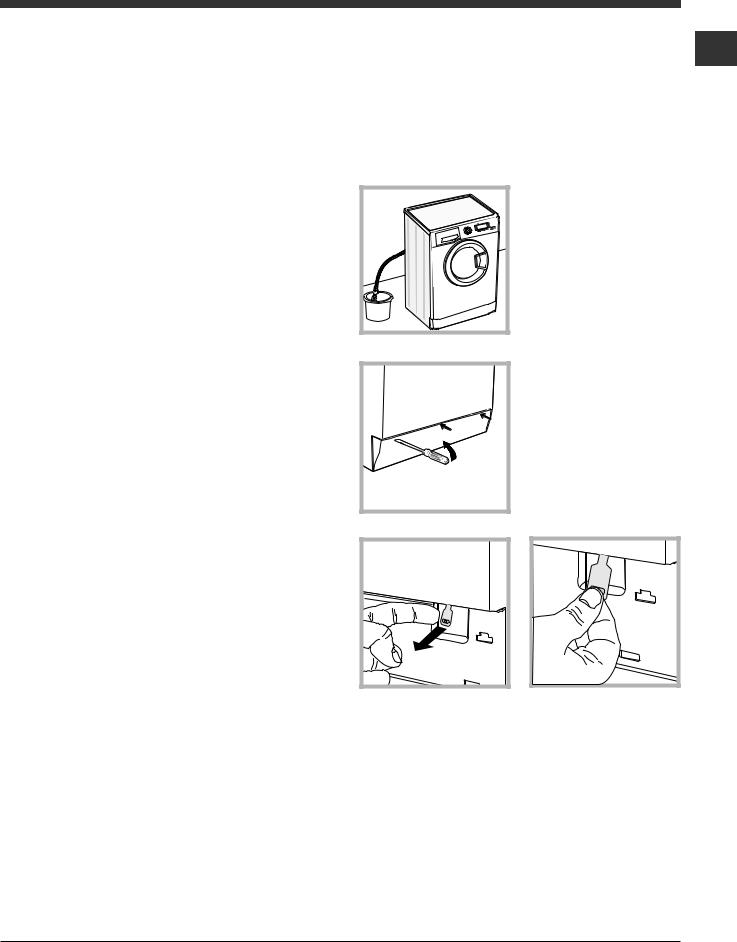
Opatření a rady
! Pračka byla navržena a vyrobena v souladu s platnými mezinárodními bezpečnostním předpisy. Tato upozornění jsou uváděna z bezpečnostních důvodů a je třeba si je pozorně přečíst.
Základní bezpečnostní pokyny
•Toto zařízení bylo navrženo výhradně pro použití v domácnosti.
•Zařízení nesmí být používáno osobami (včetně dětí) se sníženými fyzickými, senzorickými nebo mentálními schopnostmi a s nedostatečnými zkušenostmi a znalostmi,
s výjimkou případu, kdy toto použití probíhá pod dozorem nebo na základě pokynů osoby zodpovědné za jejich bezpečnost. Děti musí být pod dohledem, aby se zajistilo, že si nebudou se zařízením hrát.
•Pračku mohou používat pouze dospělé osoby podle pokynů uvedených v tomto návodu.
•Nedotýkejte se zařízení bosí nebo v případě, že máte mokré ruce či nohy.
•Nevytahujte zástrčku ze zásuvky tahem za kabel, ale uchopením za zástrčku.
•Neotvírejte dávkovač pracích prostředků během činnosti zařízení.
•Nedotýkejte se odčerpávané vody, protože může mít velmi vysokou teplotu.
•Nepokoušejte se o násilné otevření dvířek: mohlo by dojít k poškození bezpečnostního uzávěru, který zabraňuje náhodnému otevření.
•Při výskytu poruchy se v žádném případě nepokoušejte o opravu vnitřních částí zařízení.
•Vždy mějte pod kontrolou děti a zabraňte tomu, aby se přibližovaly k zařízení během pracího cyklu.
•Během pracího cyklu mají dvířka tendenci ohřát se.
•V případě potřeby přemísťujte pračku ve dvou nebo ve třech a věnujte celé operaci maximální pozornost. Nikdy se nepokoušejte zařízení přemísťovat sami, je totiž velmi těžké.
•Před zahájením vkládání prádla zkontrolujte, zda je buben prázdný.
Likvidace
•Likvidace obalových materiálů: při jejich odstranění postupujte v souladu s místním předpisy a dbejte na možnou recyklaci.
•Evropská směrnice 2002/96/EC o odpadních elektrických a elektronických zařízeních stanovuje, že staré domácí elektrické spotřebiče nesmí být odkládány do běžného netříděného domovního odpadu. Staré spotřebiče musí být odevzdány do odděleného sběru, a to za účelem recyklace a optimálního využití materiálů, které obsahují, a z důvodu předcházení negativním dopadům na lidské zdraví a životní prostředí. Symbol “přeškrtnuté popelnice” na výrobku vás upozorňuje na povinnost odevzdat zařízení po skončení jeho životnosti do odděleného sběru.
Spotřebitelé by měli kontaktovat příslušné místní
úřady nebo svého prodejce ohledně informací týka- CZ jících se správné likvidace starého zařízení.
Manuální otevření dvířek
V případě, že není možné otevřít dvířka s průzorem z důvodu výpadku elektrické energie a hodláte pověsit prádlo, postupujte následovně:
1. vytáhněte zástrčku ze zásuvky elektrické sítě. 2. Zkontrolujte, zda je
hladina vody uvnitř zařízení nižší, než je úroveň otevření dvířek; v opačném případě vypusťte přebytečnou vodu vypouštěcí hadicí a zachyťte ji do vědra, jak je znázorněno na obrázku.
3. pomocí šroubováku odstraňte krycí panel nacházející se v přední části pračky (viz obrázek).
4.s použitím jazýčku označeného na obrázku potáhněte směrem ven z dorazu plastové táhlo až do jeho uvolnění; následně jej potáhněte směrem dolů a současně otevřete dvířka.
5.namontujte zpět panel, přičemž se před jeho přisunutím k zařízení ujistěte, že došlo ke správnému zachycení háčků do příslušných podélných otvorů.
17

Popis pračky
|
Ovládací panel |
|
Tlačítko |
Tlačítko |
|
Tlačítko |
TYP PRANÍ |
||
CZ |
ODSTŘEĎOVÁNÍ |
|||
|
ON/OFF |
|
|
Displej
|
|
|
Tlačítko s kontrolkou |
|
Tlačítka |
Tlačítko |
START/PAUSE |
|
VOLBY |
FUNKČNÍ |
|
Dávkovač pracích prostředků |
PROGRAMŮ |
PAMĚŤ |
|
|
tlačítka |
||
|
|
||
|
|
Tlačítko |
Tlačítko |
|
|
TEPLOTY |
|
|
|
TYP |
|
|
|
MÁCHÁNÍ |
|
|
|
Tlačítko |
Tlačítko |
|
|
ODLOŽENÉHO |
ZABLOKOVÁNÍ |
|
|
STARTU |
TLAČÍTEK |
Dávkovač pracích prostředků: slouží k dávkování pracích prostředků a přídavných prostředků (viz „Prací prostředky a prádlo“).
Tlačítko ON/OFF  : zapněte nebo vypněte pračku krátkým stisknutím tlačítka. Kontrolka START/PAUSE pomalu blikající zeleným světlem poukazuje na to, že je stroj zapnutý. Za účelem vypnutí pračky během praní je třeba držet tlačítko stisknuté déle, přibližně 3 sek.; krátké nebo náhodné stisknutí neumožní vypnutí pračky. Vypnutí zařízení během praní způsobí zrušení probíhajícího pracího programu.
: zapněte nebo vypněte pračku krátkým stisknutím tlačítka. Kontrolka START/PAUSE pomalu blikající zeleným světlem poukazuje na to, že je stroj zapnutý. Za účelem vypnutí pračky během praní je třeba držet tlačítko stisknuté déle, přibližně 3 sek.; krátké nebo náhodné stisknutí neumožní vypnutí pračky. Vypnutí zařízení během praní způsobí zrušení probíhajícího pracího programu.
Tlačítka VOLBY PROGRAMŮ: slouží k nastavení požadovaného programu (viz “Tabulka pracích programů”).
Tlačítko PAMĚŤ: držte stisknuté toto tlačítko za účelem uložení cyklu do paměti spolu s vlastními uživatelskými nastaveními. Pro vyvolání cyklu, který byl předem uložen do paměti, stiskněte tlačítko PAMĚŤ.
FUNKČNÍ tlačítka: stiskněte tlačítko kvůli volbě požadované funkce. Na displeji se rozsvítí příslušná kontrolka.
Tlačítko TYP PRANÍ  : jeho stisknutím můžete provést volbu požadované intenzity praní.
: jeho stisknutím můžete provést volbu požadované intenzity praní.
Tlačítko TYP MÁCHÁNÍ  : jeho stisknutím můžete provést volbu požadovaného máchání.
: jeho stisknutím můžete provést volbu požadovaného máchání.
Tlačítko ODSTŘEĎOVÁNÍ  : stiskněte za účelem snížení nebo úplného vyloučení odstřeďování - hodnota bude uvedena na displeji.
: stiskněte za účelem snížení nebo úplného vyloučení odstřeďování - hodnota bude uvedena na displeji.
Tlačítko TEPLOTY  : stiskněte za účelem snížení teploty: Příslušná hodnota bude zobrazena na displeji.
: stiskněte za účelem snížení teploty: Příslušná hodnota bude zobrazena na displeji.
Tlačítko ZABLOKOVÁNÍ TLAČÍTEK  : aktivace zablokování ovládacího panelu se provádí tak, že podržíte stisknuté tlačítko přibližně na 2 sekundy.
: aktivace zablokování ovládacího panelu se provádí tak, že podržíte stisknuté tlačítko přibližně na 2 sekundy.
Rozsvícená kontrolka  poukazuje na to, že je ovládací panel zablokován (s výjimkou tlačítko ON/OFF). Tímto způsobem se zamezí náhodným změnám programů, zejména když jsou v domácnosti děti. Zrušení zablokování ovládacího panelu se provádí tak, že podržíte stisknuté tlačítko přibližně na 2 sekundy.
poukazuje na to, že je ovládací panel zablokován (s výjimkou tlačítko ON/OFF). Tímto způsobem se zamezí náhodným změnám programů, zejména když jsou v domácnosti děti. Zrušení zablokování ovládacího panelu se provádí tak, že podržíte stisknuté tlačítko přibližně na 2 sekundy.
Tlačítko ODLOŽENÉHO STARTU  : stiskněte za účelem nastavení odloženého startu zvoleného programu. Doba, o kterou bude start odložen, bude zobrazena na displeji.
: stiskněte za účelem nastavení odloženého startu zvoleného programu. Doba, o kterou bude start odložen, bude zobrazena na displeji.
Tlačítko s kontrolkou START/PAUSE: když zelená kontrolka začne pomalu blikat, stiskněte toto tlačítko pro zahájení praní. Po zahájení cyklu se kontrolka rozsvítí stálým světlem. Přejete-li si přerušit praní, opětovně stiskněte tlačítko; kontrolka bude blikat oranžovým světlem. Když symbol  není rozsvícen, je možné otevřít dvířka. Za účelem opětovného zahájení cyklu
není rozsvícen, je možné otevřít dvířka. Za účelem opětovného zahájení cyklu
z místa, v němž byl přerušen, opětovně stiskněte tlačítko.
Pohotovostní režim
Za účelem shody s novými předpisy souvisejícími s energetickou úsporou je tato pračka vybavena systémem automatického vypnutí (přechodu do pohotovostního režimu – standby), který je aktivován po uplynutí 30 minut, když se pračka nepoužívá. Krátce stiskněte tlačítko ON/OFF a vyčkejte na obnovení činnosti zařízení.
Spotřeba v off-mode: 0,5 W Spotřeba v Left-on: 0,5 W
18
